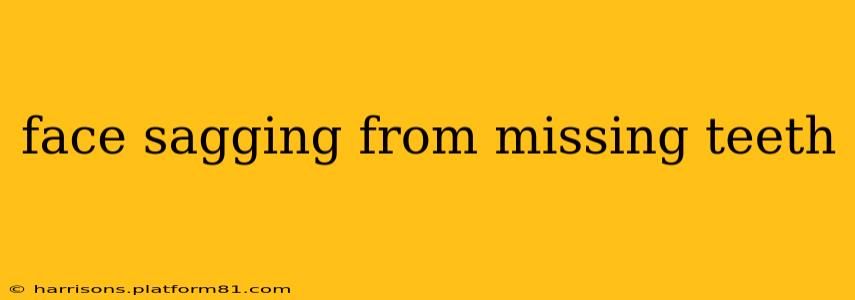Missing teeth can significantly impact your facial structure, leading to noticeable sagging. This isn't just a cosmetic concern; it affects your overall facial aesthetics and can even impact your self-confidence. Understanding the connection between missing teeth and facial sagging is crucial for effective prevention and treatment. This comprehensive guide will explore the reasons behind this phenomenon, addressing common questions and outlining potential solutions.
Why Do My Cheeks Sag After Tooth Loss?
The loss of teeth disrupts the natural support structure of your face. Your teeth, along with the alveolar bone (the bone that supports your teeth), play a crucial role in maintaining facial volume and shape. When teeth are lost, the bone begins to resorb, or shrink, leading to a decrease in bone density. This bone loss causes a collapse of the supporting structures, resulting in the sagging of the cheeks, lips, and jawline. Imagine a tent: the poles (teeth and bone) hold up the canvas (skin). Remove the poles, and the canvas sags.
Does Losing Teeth Change Your Face Shape?
Absolutely. The loss of teeth and subsequent bone resorption significantly alters your facial structure. This change isn't always immediately dramatic but becomes more noticeable over time. The gradual loss of bone volume can lead to a sunken appearance in the cheeks and jawline, making the face appear older and more gaunt. The degree of change depends on factors like the number of missing teeth, the location of the missing teeth, and individual bone density.
How Can I Prevent Face Sagging After Tooth Extraction?
Proactive measures are essential to minimize or prevent facial sagging after tooth loss. The most effective strategy is to replace missing teeth as soon as possible. This prevents bone resorption and maintains facial support. Options include:
-
Dental Implants: These are titanium posts surgically placed into the jawbone to act as artificial tooth roots. They provide excellent support and stimulate bone growth, preventing further bone loss. They are often considered the gold standard for tooth replacement.
-
Dental Bridges: Bridges are artificial teeth that span the gap created by missing teeth, supported by adjacent teeth or implants.
-
Dentures: Dentures are removable appliances that replace missing teeth. While they restore chewing function and aesthetics, they don't prevent bone loss as effectively as implants or bridges.
Regular visits to your dentist for checkups and professional cleaning are also crucial. Early detection and treatment of gum disease, another contributing factor to bone loss, are essential.
Does Bone Grafting Help with Sagging Cheeks?
Bone grafting is a surgical procedure often used to augment the jawbone before placing dental implants. This procedure involves adding bone material to the area where bone loss has occurred. By rebuilding the bone structure, it can help to restore facial volume and improve the overall appearance of the sagging cheeks. However, it's important to understand that bone grafting is a separate procedure from addressing the sagging skin itself.
Can I Reverse Face Sagging Caused by Missing Teeth?
While you can't fully reverse the bone loss that has already occurred, you can significantly improve the appearance of facial sagging by replacing missing teeth. Dental implants, in particular, are highly effective in stimulating bone regeneration and restoring facial support. Other procedures, such as facial fillers or a facelift, might be considered to address the sagging skin itself, but these often address the symptoms rather than the underlying cause.
What Are the Best Treatments for Sagging Face Due to Missing Teeth?
The best treatment depends on your individual circumstances and the extent of bone loss. Your dentist or periodontist will conduct a thorough examination and recommend the most suitable approach. Options include:
- Dental Implants: A long-term solution offering excellent support and bone stimulation.
- Bone Grafting: To rebuild bone structure prior to implant placement or other restorative treatments.
- Dental Bridges: A fixed solution supported by adjacent teeth or implants.
- Dentures: A removable option, but less effective in preventing further bone loss.
- Facial Fillers: To address skin sagging directly.
- Facelift: A surgical procedure to lift and tighten sagging skin.
Consult a dental professional to discuss the best course of action for your specific situation. Early intervention is key to minimizing the long-term effects of missing teeth on facial aesthetics.
